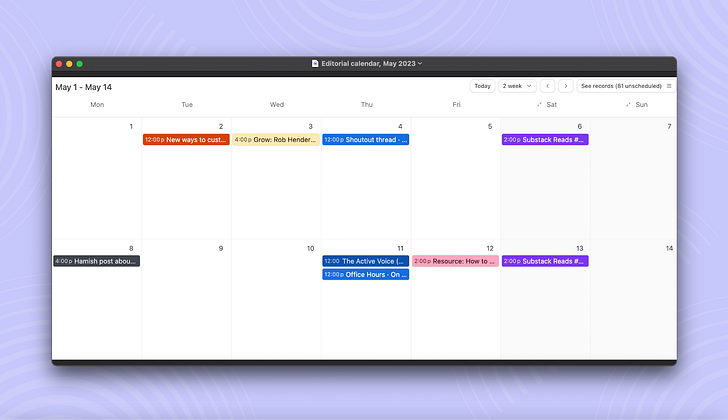Posting consistently: When to publish
Setting your schedule and building a habit to do the work
In the third part of our series on building an editorial strategy to underpin your output, we look at how to create the process that propels your writing habit. Visit the full series.

In part one of our series, we helped you get clear on your goals. In part two we helped you think through formats, style, and design templates to answer What will you publish?
In part three, we’ll look at when to publish. After studying the growth of thousands of publications, our data team recommends targeting one post a week as a benchmark. Your growth is tied to your output. When you post, it gives existing readers a reason to share, and new readers are more likely to bump into your work.

While we’ll offer tools today for planning, the best thing you can do is start writing.
Setting a schedule
Let’s get one thing out of the way first: writers have mixed feelings about setting a schedule. Some writers find that publishing at the same time and day each week helps them create their best output, while others find it stifling.
Although our data team recommends posting once a week, the format and timing can be unique to your audience.
Format: The format type doesn’t matter as much as consistency does. Your weekly post doesn’t have to be a lengthy essay; it could be a short post, link roundup, or voice note.
Timing: There is no magic day or time to publish. Put yourself in your readers’ shoes. Do they need your writing to help them with their job? Then publishing first thing in the morning on a weekday might be best. Do they read your posts for fun? Then publishing on the weekends or in the evening might mean your post arrives right when they have time to sit back, relax, and read. Think about when your subscribers’ reading habits might best align with the time you have to produce and publish your posts.
Tools to plan, write, and publish
We polled Substack Writers and found myriad toolkits that suit them. Writers all emphasize: do what works for you.
Planning
Make a running list of ideas:
keeps a “swipe file” to store bits and pieces of inspiration. Some writers start a new draft in Substack or keep a running Google Doc, and others keep a note on their phone or in a notebook to record their ideas.Create a calendar: Turn your ideas into action by naming a date you want to publish the idea on. At Substack, we use Google Docs for drafting and editing, weekly meetings to plan ahead, and Airtable to track which posts are in production or going up on Substack Reads and On Substack. While Airtable works well for us (we’re in no way affiliated), writers on our team have used a number of different programs and tools in the past.

Tell your friends and subscribers: When
was just getting started, he emailed a small group of trusted friends every two weeks letting them know what work he’d done and what he planned to do in the next two weeks. Today, at the bottom of each newsletter, he previews the next post to subscribers so they can get excited about it and hold him accountable if it doesn’t arrive.

Writing
Block off your calendar: Successful writers block out writing time rather than scrambling to find it in between other commitments. Set aside time when you know you think clearest or have the most energy.
Attend a writers’ hour: If writing with others helps you stay accountable, find a writing group.
is one of hundreds of writers who attend London Writers’ Salon’s Writers’ Hour, hosted virtually every morning.
Advice from fellow writers
Here’s advice to keep in mind from some bestselling writers who’ve grown from the ground up on Substack:
Quality and consistency matter most
Things that don’t matter: your design, your title, your strategy, your growth plan, vision . . . most things. Things that matter: quality, consistency. There’s no trick to making something like this grow. Growth comes from publishing something valuable, that people want to share with their friends and colleagues, over and over and over. —
Read more: Ten lessons learned from growing Lenny’s Newsletter to 500,000 subscribers
Just start writing
Based on my own experience of building my newsletter over the years, the most important thing to focus on in the beginning is the actual writing. —
Read more: Advice on recognizing what you’ve accomplished
Don’t quit when things get tough
“Be consistent” is great advice. It would benefit Peak Notions if I could do that. “Don’t quit when conditions aren’t optimal—find a way to make it work, publish regularly, and keep going!” would have been more fitting advice for me this year. I’ve lived between Ireland and the U.K. this year, moved house three times, and had a lot of unexpected hurdles and changes. Peak Notions has grown despite the unpredictability of my schedule. —
Read more: How Laura made more money on Substack than anywhere else
Write at a pace you can maintain
I’ve learned that the only way you can earn people’s trust is by consistently keeping your word and delivering on what you’ve promised. So no matter what your business is, make sure that your users, readers, or customers know they can rely on you to send your product on time and consistently. Don’t start something if you’re unsure whether you can stick with it on a regular cadence. —
Read more: How consistency over time helped The Profile build its readership
Do the best you can with the tools you have
There’s a reason people warn you against getting ahead of yourself. You have to start where you are and muddle your way forward from there. —
Read more: Dear writer, What does it take to grow? What has worked for you?

What motivates you to publish? How do you stay motivated? Join the conversation:

If you want to gather more inspiration on editorial strategy, visit our Grow interview series for writers’ stories. For more on building out your publication, see our resource guides.



Share this post